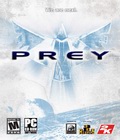Genre: FPS
Publisher: 2K Games
Developer: Human Head Studios / 3D Realms
Release Date: Q2 2006
Prey. Either you do, or you are. It is that simple. As one of the great verb/noun words of the English language, it confuses the daylights out of English as a Second Language (ESL) speakers and defines the duality of our existence. It has been nearly as long as it takes to go from high school to doctoral thesis on this concept for Prey to finally reach the gaming public, but this time, it's for real.
For the single-player story, we find the lead character, Tommy, typecast into the role of reluctant hero. In that ever-so-popular thread, Human Head and company have done a great deal to make Prey everything but the average FPS release. Yes, it uses the Doom 3 engine. Yes, he's abducted by aliens, along with a bunch of his people. Yes, Tommy's cast as a Cherokee Indian to lend him some mystic spirituality. Yes, he's going to save everyone only because of his selfish love for a few of those people.
With the backdrop set, Prey strives to deliver the rise of a hero through the conduit of a fantastic voyage aboard a ship that's a living entity. The ship itself can remind you of a living ship from a TV series. No, It's not a Tardis, but rather a big organic environment just as treacherous as anywhere else in the universe. This is where Prey begins to step into its own, and at this preview stage, it looks to be going the distance.
Beginning with the engine and environment, Prey pulls some smooth moves and some fast tricks to create the user experience. Conceiving the environment as a living ship allows Prey to have a very organic look, which not only allows for a different appearance, but also enables a great deal more creativity in the design, threats, assets, and functions throughout the game. While it may just seem like a coy way to mask normal threats within an enemy environment, it seems to provide an eerie feeling of not really knowing the enemy – where it is, who it is, or what it wants.
What the enemy wants is cruelly self-evident in the scene where Tommy's girlfriend floats by, strapped to a table hanging from an overhead conveyor – undoubtedly heading for, well, processing. As Tommy's initial motivation to heroic efforts, she plays a pivotal role, and it almost seems to hearken back to the days of classic titles where the damsel in distress was just out of reach, again and again.
And along comes your spirituality. Tommy's roots shine as Prey places him in a situation paramount to the survival of his people. In a fair connection with Cherokee spiritualism, his ancestors reach out from the ages and come to his aid. The main form is a spiritual hawk, which is the biggest tactical aid present in the single-player campaign. Don't mess with the hawk. His name is Talon, and he proves quite useful.
Thankfully, the ship has some communications interfaces, and it is not in English (which would be ridiculous). Talon serves a valuable purpose in translating when he is nearby, much like a living ship mentioned earlier in this article. Essentially, Talon is the edification of Tommy's supernatural powers and connection, but don't be fooled – Tommy's spirit can do quite a bit with his ancestors' help, too.
The Spirit Walk is truly something to behold. Tommy takes ethereal form, just like Talon, leaving his body behind to venture forth only with a Spirit Bow as a weapon. While he may be in a non-materialized form, that doesn't mean he cannot do real damage. To keep things from getting out of control, there is a mechanic limiting the amount of arrows you can fire, in conjunction with how long you can be on a Spirit Walk.
Spirit Walks serve another purpose. While Prey is an FPS, there are also puzzle elements within the title that pull it toward the adventure genre. Spirit Walks are necessary at certain points to activate triggers to progress throughout the game. This points to a thoughtful integration intended to accommodate players to a mode that is initially awkward and a bit uncomfortable. If there is concern about getting assaulted, or even killed while out on a Spirit Walk, there is little – well, not a whole lot – to worry about. As soon as Tommy takes damage, his ethereal body snaps back to defend the physical, so as to preserve himself for the future torture of watching his girlfriend pass by on the way to her death.
So far, Prey exhibits a storyline with some carefully thought-out integration of the best of the best. After all, it is loosely based on Joseph Campbell's "The Hero's Journey," the same man George Lucas pulled from when making his incredible hit in the 1970s. Any guesses on what that one was?
Before Talon falls asleep from all of the storytelling and returns home out of boredom, we better move on to the gameplay and see if Prey can pass muster for use of the Doom 3 Engine, and get creative enough to make the game something more than a Doom3.x environment with Imp wallpaper to make it look all hairy and fireballish. Prey manages to do a bit of that, with little acid pots and sphincter-like doorways, but it then gets funky with the gravity on this living ship.
The fearless developers from Human Head Studios call it Wall Walking: flip a switch, and you have a path where it's like wearing gravity boots, except you can even walk on sidewalls, not just upside down. Yes, these are realms of an artificial gravity when activated, and switches at the ends activate them. Can they be turned off while you are walking, resulting in Tommy falling to his death? Absolutely, but as there is light in the darkness, Tommy has the option to do the same to enemies, leveling the playing field. All puns aside, this was an interesting, and sometimes confusing element of the game, but it keeps the endless progression from corridor to corridor from getting old.
Taking Wall Walking into multiplayer action is where the sweet spot of Prey truly lies. One level we got our hands on was like being in the midst of an M.C. Escher drawing, with almost all of the walls turned on. It was impossible to keep track of where the enemy was, and at first, it was impossible to keep a handle on where to go, or where we had been. That was a real surprise. To continue, we were dropped into a level with two spheres in the center of a structure, somewhat like the earth and moon in relationship. They were spaced within the structure and had their own gravity, bringing a 360-degree element to the deathmatch. At this point, the levels look innovative, and are going to be either exciting or infuriating for gamers. Gone is the day of a 2D map. The day of a 3D compartmentalized structure is attacked by Prey, as gamers will be forced to grasp both space and gravity in an environment where "top" and "bottom" will be difficult, if not impossible, to identify.
As the actual control and weapons mechanics go, Tommy has fairly standard offensive weaponry in terms of the damage they inflict, with the exception of Spirit Walking, which provides the use of an ethereal bow and arrow. Movement still needed some smoothing, but this has likely been resolved by this point. Of course, anyone who played Doom 3 will find the feel relatively the same, except for the Wall Walking, the Spirit Walking and the Deathwalk. Deathwalk, you say? Indeed, but we can't tell you everything about the game. In a few weeks, Prey is going to hit the shelves, and when it does, we'll be back to let you know how Human Head Studios finished up this eternally awaited title, and if 2K made a good decision in finally bringing Prey back to life.
Don't forget to watch for our upcoming doctoral thesis on how mysticism, theology, and science fiction come together to make a great game. Maybe, just maybe, you won't have to bore yourself with our 530 pages of droning, and Prey will serve as a sample for your gaming pleasure.
More articles about Prey 2006











 Prey tells the story of Tommy, a Cherokee garage mechanic stuck on a reservation going nowhere. His life changes when an otherworldly crisis forces him to awaken spiritual powers from his long-forgotten birthright. Abducted along with his people to a menacing mothership orbiting Earth, he sets out to save himself and his girlfriend and eventually his planet.
Prey tells the story of Tommy, a Cherokee garage mechanic stuck on a reservation going nowhere. His life changes when an otherworldly crisis forces him to awaken spiritual powers from his long-forgotten birthright. Abducted along with his people to a menacing mothership orbiting Earth, he sets out to save himself and his girlfriend and eventually his planet.























